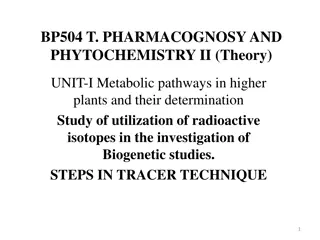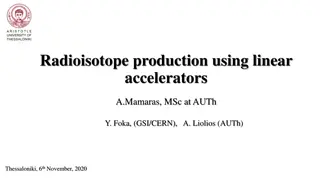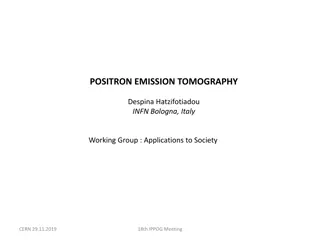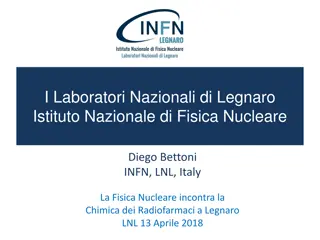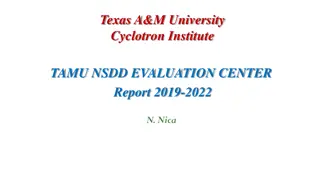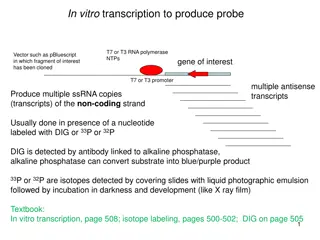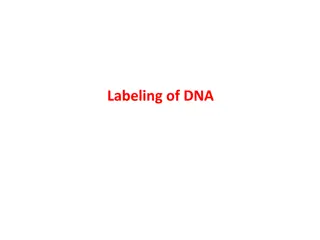Innovative Approach to Radioisotope Production Using IFMIF-DONES Neutron Source
An assessment on the production of radioisotopes in the IFMIF-DONES test cell highlights the significance of 99Mo, the precursor of Technetium-99m used in radiopharmaceutical applications. The global shortage of 99Mo due to reactor maintenance issues has led to the exploration of alternative methods
3 views • 20 slides
Exploring Radio Tracer Techniques in Pharmacognosy and Phytochemistry II
In this unit, the focus is on metabolic pathways in higher plants and leveraging radioactive isotopes for biogenetic studies. Topics covered include steps in tracer techniques, selection of radioisotopes, preparation of labeled compounds, and insertion of radio-labeled metabolites in plant parts usi
0 views • 9 slides
Advancements in Radioisotope Production Using Linear Accelerators for Medical Imaging
Exploring the potential of linear accelerators for producing radioisotopes used in PET imaging, this comprehensive study delves into the efficiency and cost-effectiveness of utilizing linac-based systems. Key considerations include accelerator designs, production yield estimations, and numerical cal
0 views • 12 slides
Positron Emission Tomography: Applications in Society and Recent Developments
Positron Emission Tomography (PET) is a medical imaging technique focusing on metabolic differences in the body. By using positron-emitting radioisotopes, PET can detect how molecules are taken up by healthy and cancerous cells, aiding in accurate tumor localization with lower doses. The evolution o
0 views • 6 slides
Advancements in Nuclear Physics Research at Laboratori Nazionali di Legnaro
Laboratori Nazionali di Legnaro (LNL) in Italy is an esteemed institute under the INFN focusing on nuclear physics and nuclear astrophysics. With cutting-edge accelerators and experimental apparatuses, LNL conducts research on nuclear spectroscopy, reaction dynamics, production of exotic beams, and
0 views • 25 slides
Texas A&M University Cyclotron Institute NSDD Evaluation Center Report 2019-2022
The Texas A&M University Cyclotron Institute's NSDD Evaluation Center has been actively involved in evaluating nuclear structure and decay data, focusing on mass-chain evaluations and contributing significantly to precision nuclear data production. Through targeted experiments and collaborations, th
1 views • 19 slides
Applications of Radioisotopes in Nuclear Medicine
Nuclear medicine utilizes radioisotopes to provide crucial diagnostic information about the functioning of specific organs and to treat various conditions. Diagnostic techniques in nuclear medicine involve using radioactive tracers that emit gamma rays from within the body. Positron Emission Tomogra
0 views • 19 slides
Advances in Medical Radioisotope Production: Focus on 67Cu at Texas A&M University
Texas A&M University's Nuclear Data Program is at the forefront of research on medical radioisotopes, particularly highlighting the production and potential applications of 67Cu. This isotope offers promising benefits for diagnostic imaging and radioimmunotherapy due to its low-range, highly ionizin
0 views • 12 slides
Understanding In Vitro Transcription and Probe Production
In vitro transcription involves utilizing T7 or T3 RNA polymerase to produce multiple single-stranded RNA copies of a gene of interest. These transcripts can be used to create probes for detecting specific RNA sequences. The process often involves labeling with DIG or radioisotopes like 33P or 32P,
0 views • 8 slides
Understanding Nucleic Acid Labeling and Detection in Molecular Biology
Nucleic acid labeling and detection play crucial roles in molecular biology, where hybridization helps identify complementary DNA or RNA sequences. Techniques like using labeled probes are essential for precise detection in complex nucleic acid mixtures. Understanding radioactive activity units and
0 views • 22 slides

